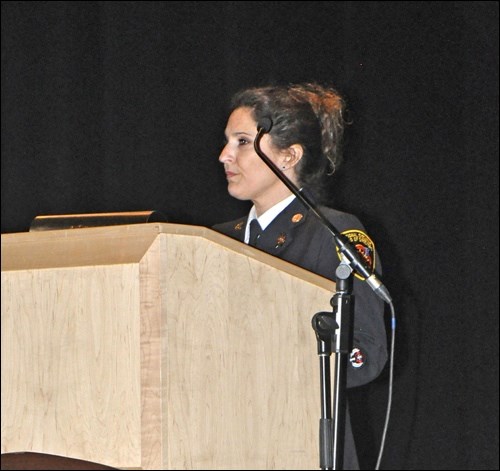The delegates who took in the speakers at the Saskatchewan Association of Fire Chiefs Conference came away with a lot to think about when they returned to their home communities.
The closing keynote address Saturday focused on the issue of post-traumatic stress disorder, an important topic for the delegates as the theme of the conference was Challenges of Fire Fighter Health and Safety in a Changing Environment.
PTSD has been an issue for armed forces personnel in combat situations. But it is also a big concern for emergency and fire personnel engaged in situations where they are exposed to death and destruction.
The delegates at the Dekker Centre heard from Nathalie Michaud, and then her spouse James Seale, on the issue. Both are PTSD sufferers and survivors.
Seale has served in the military. His presentation particularly relayed his own experiences and life having a spouse suffering from PTSD, and how they deal with it on a daily basis.
His message to those in the room was one of hope, that there was "light at the end of the tunnel."
Michaud's goal during her presentation was to share her experience and raise awareness. She spoke of PTSD symptoms and impacts such as triggers, flashbacks, hyper-arousal and short-term memory loss.
She pointed to the alarming number of suicides due to PTSD among firefighting personnel.
One of those was Fire Chief Richard Stringer who committed suicide Jan. 30, 2010 while suffering from PTSD.
Michaud had a personal connection to Stringer. He was her husband.
It was one of a few incidents that triggered her own PTSD. She later responded to the Lac-Megantic rail disaster tragedy in Quebec and described being overcome by PTSD while on that horrific assignment. The sights and sounds of the devastation had triggered flashbacks to one of her earlier assignments.
"I had no idea that I was being triggered by the sights of the remains of the buildings, the smells and sounds," she said.
Michaud urged the audience to be aware of the issue of PTSD.
"This injury is a scar that's left from the sacrifices we make as emergency workers in order to help others in our community," she said.
She called for emergency workers to be able to have safe places to go to that have tools and programs that can prevent and heal PTSD.
"We can make a change. We can make our voices be heard," said Michaud.
Friday afternoon included sessions that focused mainly on smooth operation of fire departments. Fire Chief Dan Lemieux from Grand Prairie Fire Department spoke on the development and importance of operational guidelines.
He discussed Grande Prairie FD's model for a standard operating procedure and spoke on how to establish an SOP, how it should be implemented and how to make changes to it.
Saskatchewan Fire Commissioner Duane McKay spoke about the provincial ministry of Emergency Management and Fire Safety and how it assists Saskatchewan communities and fire departments.
He reiterated EMFS's commitments on post-traumatic stress disorder and critical incident stress management.
McKay also spoke on the wildfire operation impacts from last year. He called the northern wildfires "significant in impact" with 99 lost properties and close to 15,000 evacuees. He said there were $100 million direct costs and indirect costs and economic impacts to be determined.
A major review that took place after the wildfires was completed before the election, and results will be released soon. McKay notes as many as 200 recommendations are included.
He also spoke about the new Fire Safety Act that was brought in during the summer and the myriad of items addressed in it. "It gives you all kinds of powers for things you never had before," said McKay.
The changes addressed such things as definitions of firefighter and fire services, ensuring clear liability for firefighters and departments, providing transparent rules on entry to premises, ensuring authority for the Province to assist local fire departments that may be overwhelmed by or unable to respond to a fire or emergency, as well as a regulatory framework.




